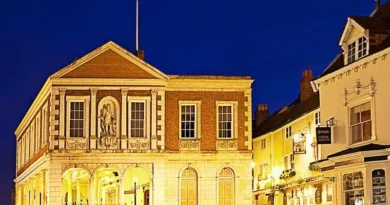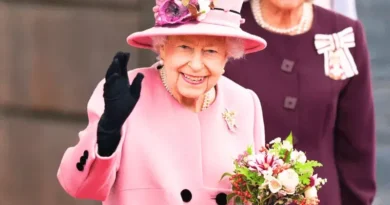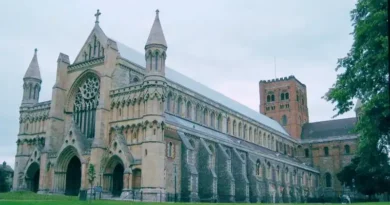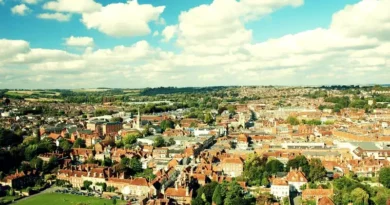The Changing of the Guard at Windsor Castle
Key Takeaways
| Category | Key Takeaways |
|---|---|
| Windsor Castle Overview | Windsor Castle is one of three official residences of The King and has been inhabited by British sovereigns for over 900 years. It is the largest inhabited castle globally. |
| Ceremony Overview | The Changing of the Guard at Windsor Castle is a ceremonial handover of duties, also known as ‘Guard Mounting.’ It takes place at 11:00 am on select days, usually Tuesdays, Thursdays, and Saturdays. |
| Guards Involved | The ceremony involves the Household Division, comprising five infantry regiments (Grenadier Guards, Coldstream Guards, Scots Guards, Irish Guards, Welsh Guards) and two cavalry regiments (Life Guards and Blues and Royals). |
| Historical Significance | The ceremony reflects centuries of royal tradition and the military precision of elite troops, some of whom have served in combat roles. |
| Uniforms and Distinctions | The Guards are recognizable by their distinctive uniforms and unique features, such as the plumes in their bearskin helmets, which vary between regiments. |
| Viewing Tips for Visitors | Best viewing spots include Windsor High Street and under the Corn Exchange at Windsor Guildhall. Visitors must purchase an entrance ticket to Windsor Castle to witness the ceremony. |
| Significance During King’s Residence | When The King is in official residence, the ceremony gains added significance and grandeur, with the parade taking place on the Castle Forecourt. |
| Year-Round Attraction | The Guard March takes place throughout the year, though specific days may vary. The ceremony is weather-dependent, and schedules should be checked in advance. |
| Other Ceremonial Locations | Similar ceremonies occur at Buckingham Palace, the Tower of London, and the Horse Guard Parade. Buckingham Palace is the most famous location, with ceremonies involving multiple sites. |
| Visitor Experience | Visiting Windsor Castle offers a chance to see the Guard ceremony and explore the rich history, stunning architecture, and vast grounds of the castle. A full day is recommended for the visit. |
| Additional Resources | Official websites like www.royalcollection.org.uk and www.windsor.gov.uk provide further information about Windsor Castle and other attractions. |
Let’s discuss in detail:
Introduction
The Changing of the Guard ceremony at Windsor Castle is a deeply rooted British tradition that combines military precision, historical significance, and royal pageantry. It is one of the most popular attractions in Windsor, drawing thousands of visitors each year.
Windsor Castle: A Royal Residence with a Rich History
Windsor Castle, one of three official residences of The King, has been home to British sovereigns for over 900 years. The castle is the largest inhabited castle worldwide and the oldest continuously occupied royal residence.
Its historical significance and grandeur make it a fitting location for the Changing of the Guard ceremony, which reflects centuries of royal tradition.
The Ceremony: An Overview

The Changing of the Guard at Windsor Castle is a ceremonial handover of duties between the old Guard, who have been on duty, and the new Guard. This process is also known as ‘Guard Mounting’. The ceremony usually takes place at 11:00 am within the castle grounds on Tuesdays, Thursdays, and Saturdays, weather permitting. There is no Changing of the Guard on Sundays, and the schedule can vary from month to month, so it is always advisable to check in advance.
The ceremony is not just a simple exchange of responsibility; it is a colourful and meticulously choreographed event that showcases British pageantry at its finest. The Guards involved are part of the Household Division, entrusted with protecting the Sovereign since 1660. These elite troops consist of five infantry regiments—the Grenadier Guards, Coldstream Guards, Scots Guards, Irish Guards, and Welsh Guards—and two of the Household Cavalry, the Life Guards and the Blues and Royals.
Many of these soldiers have served in combat roles overseas, adding a layer of respect and dignity to their ceremonial duties.
The Procession and the Ceremony
The Changing of the Guard ceremony begins with the Windsor Castle Guard forming outside the Guard Room. The New Guard, led by a Regimental Band, Corps of Drums, or occasionally a Pipe Band, arrives in a procession feast for the eyes and ears. The handover of duties, including the changeover of sentries, takes place over the next 45 minutes. The old Guard, after completing their duties, marches back to Victoria Barracks in Windsor town.
When the King stays at Windsor Castle, the ceremony becomes more special and grand. The parade happens right in the Castle’s Forecourt, making it an even more impressive sight.
Here is a map of the changing of the guard route at Windsor Castle:
Viewing the Ceremony: Tips for Visitors
If you wish to watch the Changing of the Guard, there are several vantage points where you can enjoy the ceremony. The best places to see the Guards marching are on Windsor High Street or under the Corn Exchange at Windsor Guildhall. You can watch the Guards march from Victoria Barracks on Sheet Street, up the High Street, and into Windsor Castle from these spots.
However, if you want to witness the actual ‘changing’ ceremony itself, you will need to purchase an entrance ticket to Windsor Castle. The ceremony takes place inside the Castle Precincts, specifically in the Lower Ward, outside the Guardroom. It is advisable to allow plenty of time to get into the Castle, especially during peak tourist seasons, as the event draws large crowds.
The Guard March: A Year-Round Attraction
The Guard March takes place all year round, though the specific days of the week can vary depending on the schedule set by the British Army. The ceremony is weather-dependent, so checking the schedule in advance is always a good idea. This year, the ceremony will be held on Tuesdays, Thursdays, and Saturdays, barring any changes due to weather or other factors.
The Guards: Distinctive Uniforms and Historical Significance
The Guards involved in the ceremony are easily recognizable by their distinctive uniforms, which vary slightly between the different regiments. The five regiments of Foot Guards each have unique features in their uniforms, such as the plumes in their bearskin helmets and the pattern of their buttons. For instance, the Grenadier Guards are known for their white plumes, while the Coldstream Guards sport red plumes. These subtle differences make it possible to identify which regiment is on duty.
The Household Cavalry, consisting of the Life Guards and the Blues and Royals, also plays a significant role in British ceremonial events. The Life Guards wear striking red tunics with white-plumed helmets, while the Blues and Royals are distinguished by their blue tunics and red-plumed helmets. These regiments are known for their discipline and precision in ceremonial duties and operational roles within the British Army.

Other Ceremonial Locations
While Windsor Castle offers a unique setting for the Changing of the Guard, similar ceremonies take place at other royal residences, including Buckingham Palace and the Tower of London. Buckingham Palace is perhaps the most famous Changing of the Guard location. The ceremony there involves multiple locations, including St. James’s Palace and Wellington Barracks, and typically starts at 10:45 am and lasts 45 minutes. This event takes place on Mondays, Wednesdays, Fridays, and Sundays. Check the schedule in advance, as it can vary due to weather or other factors.
Accurate timings are:
- 10:43 am: The Old Guard leaves St. James’s Palace and arrives at Buckingham Palace shortly after.
- 11:00 am: The official ceremony starts at Buckingham Palace.
- The entire ceremony typically lasts about 45 minutes, concluding around 11:45 am.
Another notable location is the Horse Guard Parade, where the Queen’s Life Guard changes daily at 11:00 am, Monday to Saturday, and at 10:00 am on Sundays. This ceremony involves the Household Cavalry and is a must-see for those interested in British military traditions.
Visiting Windsor Castle

For those planning to visit Windsor Castle and witness the Changing of the Guard, it is worth noting that the castle is open throughout the year but not every day of the week. Visiting the castle offers the chance to see the Guard ceremony and explore the rich history and stunning architecture of one of Britain’s most iconic landmarks.
The castle grounds are vast, and there is much to see, including the State Apartments, St. George’s Chapel, and the beautiful gardens. The Castle Precincts, where the Changing of the Guard takes place, are a key part of the visitor experience.
To fully appreciate the ceremony and the castle itself, it is advisable to allocate a full day for your visit.
Additional Information and Resources

For those interested in learning more about Windsor Castle, the official website (www.royalcollection.org.uk) offers a wealth of information about the castle’s history, current exhibitions, and visitor information. For general information about Windsor, including other attractions and events, www.windsor.gov.uk is a useful resource.
Conclusion
The Changing of the Guard at Windsor Castle is a quintessentially British experience that should not be missed. It is a ceremony steeped in history, tradition, and royal pageantry, offering a unique glimpse into the heritage of the British monarchy. Whether you are a first-time visitor to Windsor or a seasoned traveller, witnessing this ceremony will surely be a highlight of your trip.
As you stand on the cobblestones of Windsor High Street or within the Castle Precincts, watching the precision of the Guards as they carry out their duties, you become part of a tradition that has endured for centuries.
The sight of the Guards in their splendid uniforms, the sound of the band playing, and the sense of history around you make the Changing of the Guard at Windsor Castle an unforgettable experience.
FAQ
When does the Changing of the Guard at Windsor Castle take place?
The ceremony typically occurs at 11:00 am on Tuesdays, Thursdays, and Saturdays, weather permitting. There is no Changing the Guard on Sundays. It’s advisable to check the official schedule before your visit, as dates and times can change, sometimes at short notice.
Where inside Windsor Castle does the ceremony occur?
The Changing the Guard ceremony usually occurs outside the Guardroom in the Lower Ward. When the monarch is in residence, it may occur in the Upper Ward on the Quadrangle lawn, providing a different ceremonial backdrop.
Do I need a ticket to watch the Changing of the Guard?
Yes, to view the ceremony inside Windsor Castle, you must purchase an entrance ticket. However, you can watch the guards march through Windsor town without a ticket, offering a glimpse of the pageantry for free.
What is the best vantage point to watch the ceremony inside the castle?
Standing by the railings just below St George’s Chapel in the Lower Ward offers an excellent view of the ceremony. Arriving by 10:30 am is recommended to secure a good spot, as crowds gather quickly.
Can I see the guards marching without entering the castle?
Yes, the new guard departs from Victoria Barracks around 10:45 am, marching through Windsor town before entering the castle. This procession is visible without entering the castle and is a popular spectacle for visitors.
How long does the Changing of the Guard ceremony last?
The ceremony lasts approximately 45 minutes, including the handover of duties and the changeover of sentries. It’s a detailed ritual showcasing British military tradition.
Is the ceremony held in all weather conditions?
The ceremony can be cancelled in wet weather. In such cases, a ‘Wet Mount’ is called, and the guards march without musical support. It’s advisable to check for updates on the day of your visit.
Which regiments participate in the Changing of the Guard at Windsor Castle?
The Windsor Castle Guard is typically provided by one of the five regiments of Foot Guards: Grenadier, Coldstream, Scots, Irish, or Welsh Guards. Each regiment has distinctive uniforms and traditions.
What is the route taken by the guards during the march?
The new guard departs Victoria Barracks, proceeds up Sheet Street, turns left into the High Street, passes the Parish Church and Guildhall, and then turns right onto Castle Hill, entering Windsor Castle. This route allows public viewing along the way.
Are there Changing the Guard ceremonies at other locations in the UK?
Yes, similar ceremonies occur at Buckingham Palace and the Tower of London in London, as well as at the Palace of Holyroodhouse and Edinburgh Castle in Scotland. Each location offers a unique version of the tradition.
Is photography allowed during the ceremony?
Yes, photography is permitted. However, be respectful and avoid obstructing others. Flash photography may be discouraged during certain parts of the ceremony.
What time should I arrive to get a good viewing spot?
Arriving at least an hour before the ceremony, especially during peak tourist seasons, is advisable to secure a good spot. Early arrival ensures better visibility and a more enjoyable experience.
Are the guards on duty actual soldiers?
Yes, the guards are fully trained infantry soldiers performing ceremonial duties. They are not actors, and their primary role is national defence.
Is there a musical performance during the ceremony?
Yes, a Regimental Band, Corps of Drums, or occasionally a Pipe Band accompanies the ceremony, providing musical support. The music adds to the ceremonial atmosphere.
Can I attend the ceremony during public holidays?
The schedule may vary during public holidays. Checking the official schedule in advance is recommended, as ceremonies may be rescheduled or cancelled.
Is there seating available for spectators?
No, there is no seating provided. Spectators stand during the ceremony. Comfortable footwear is recommended, especially for those needing to stand for extended periods.
Are there any restrictions on attending the ceremony?
No specific restrictions exist, but large bags and backpacks may be subject to security checks. It’s advisable to travel light and be prepared for security screenings.










Comments are closed.